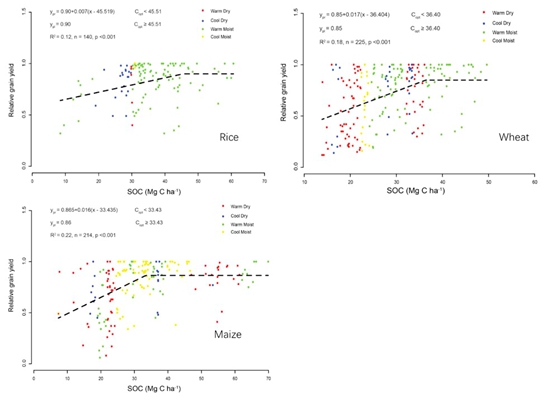The influence of nutrient management on soil organic carbon storage varies under different climates
Recently, a paper entitled “The influence of nutrient management on soil organic carbon storage, crop production, and yield stability varies under different climates” was published in Journal of Cleaner Production (IF=6.39), which according to JCR ranking, is CAS-Q1 Top journal in the categories of “Environmental Sciences and Ecology”.
Our understanding on how soil organic carbon (SOC) storage, crop yield, and yield stability are influenced by climate is limited. To critically examine this, the impact of long-term (≥10 years) application of nutrient management practices on SOC storage, crop yield, and yield stability were evaluated under different climatic conditions in China using a meta-analysis approach. The cropping area of China was divided into four distinct groups based on local climatic conditions (warm dry, DW; warm moist, WM; cool dry, CD; cool moist, CM). Results indicated that the impact of nutrient management practices on SOC storage, crop yield, and yield stability varies under different climatic zone in China (Fig. 1). Organic fertilizers (OF), combined unbalanced mineral and organic fertilizers (UMOF), and combined balanced mineral and organic fertilizers (BMOF) were able to sustain and enhance SOC storage under all climatic conditions. However, the largest increase in SOC storage across all climates was seen for BMOF. Further, corresponding values of crop productivity and yield stability were also highest for BMOF among all the nutrient management treatments. BMOF appears to be the most appropriate nutrient management strategy. A linear-plateau model indicated that relative grain yield increase before the SOC stock (Copt) reaches to the range from 33.43 to 45.51 Mg·C·ha-1, and then the increase rate slow down with the increase of SOC stock (Fig. 2). Our findings demonstrate that it is essential to optimize nutrient management strategies according to the local climate to protect soil from SOC losses, and for achieving sustainable crop production.

Fig 1. Response of SOC stocks, relative yield and yield sustainability to different fertilizer management practices under different climatic regions in China. Between-group heterogeneity (Qb) and probability (P) were used to indicate statistical differences rates between various levels of the categorized factors.

Fig 2. Relationship between SOC stocks and relative grain yields of rice, wheat and maize. Where Ypr indicates predicted grain yield. a and b indicate intercept, and slope, while x is SOC stock and Ypl is the predicted plateau-grain yield fitted with the model. And n indicates number of total observations. Copt indicates maximal yield responsive SOC stock level.
(Original link: https://www.sciencedirect.com/science/article/pii/S0959652620319697)
Present study was conducted with the support of German-Chinese cooperation on agriculture and climate change (CHN-19-02) and Coordination of International Research Cooperation on Soil Carbon Sequestration in Agriculture (CIRCASA 774378). The first author Muhammad Ahmed Waqas from Pakistan is a PhD student in the discipline of Agricultural Meteorology and Climate Change,under the guidance of Prof. Li Yue.
By Li Yu’e (liyue@caas.cn)
-
 Apr 18, 2024Opening Ceremony of the Training Workshop on Wheat Head Scab Resistance Breeding and Pest Control in Africa Held in CAAS
Apr 18, 2024Opening Ceremony of the Training Workshop on Wheat Head Scab Resistance Breeding and Pest Control in Africa Held in CAAS -
 Apr 03, 2024IPPCAAS Co-organized the Training Workshop on Management and Application of Biopesticides in Nepal
Apr 03, 2024IPPCAAS Co-organized the Training Workshop on Management and Application of Biopesticides in Nepal -
 Mar 28, 2024Delegation from the School of Agriculture and Food Science of University College Dublin, Ireland Visit to IAS, CAAS
Mar 28, 2024Delegation from the School of Agriculture and Food Science of University College Dublin, Ireland Visit to IAS, CAAS -
 Mar 25, 2024Director of World Food Prize Foundation visited GSCAAS
Mar 25, 2024Director of World Food Prize Foundation visited GSCAAS -
 Mar 20, 2024Institute of Crop Sciences (ICS) and Syngenta Group Global Seeds Advance Collaborative Research in the Seed Industry
Mar 20, 2024Institute of Crop Sciences (ICS) and Syngenta Group Global Seeds Advance Collaborative Research in the Seed Industry
